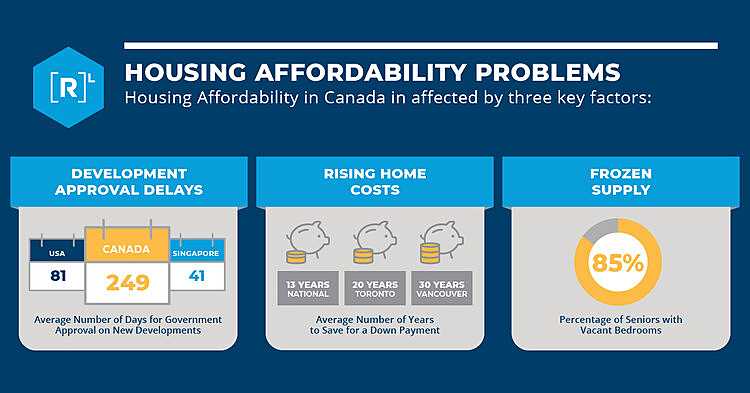Between record-high housing sales and dropping vacancy rates, it’s clear that the demand for housing remains strong in Canada—and that’s despite the economic challenges of a global pandemic.
Traditionally, we would have addressed these issues with new construction, but demand is climbing faster than we can build. Even with an increased number of housing developments, we still don’t have enough supply to accommodate the growing needs of Canadians. The reality is new construction takes time and that’s a luxury some people don’t have.
We need to bring a stronger sense of urgency to the current state of housing. At R-LABS, we believe that innovation is at the heart of the solution so we took a deep dive into the current state of housing in Canada. What we realized is, sometimes, solving for what you don’t have means taking a closer look at what you do have.
Overhoused vs. Underhoused
To solve for our lack of housing supply, we needed to know how much housing was needed and how our existing housing is being used. This led us to the concepts of overhousing and underhousing.
Underhoused: Any household with less than the recommended amount of space for its residents according to the national housing standard.
Overhoused: Any household with more space than the recommended amount of space for its residents according to the national housing standard.

The Canada Mortgage and Housing Corporation’s (CMHC) National Occupancy Standards (NOS) are a set of housing guidelines that consider the size and amenities of the home, as well as the household’s composition. Generally speaking, if occupants are not married or children, they should have their own room, and there should never be more than 2 occupants per room. We know that many households in Canada are living in underhoused environments, but what’s more surprising is that overhousing is a far more common occurrence.
Based on the 2016 Census Data, there are 12.3M vacant bedrooms across Canada – compared to the 2.09M bedrooms needed to help solve underhousing. So what’s causing the gap?
Causes of Underhousing in Canada
Housing affordability is a complex problem with multiple causes. Here are just a few of the factors contributing to underhousing in Canada:

Supply: Insufficient housing supply is the leading cause of underhousing in cities around the world. Simply put, the production of affordable housing is insufficient for the growing population. The other challenge is that affordable housing often fails to address the “Missing Middle” which refers to the lack of mid-density housing in cities. Instead, the focus remains on unaffordable detached housing or high-density developments.
Pricing: As the average home in Canada continues to soar, so does the average time it takes to save for a down payment. It will take Millennials an average of 13 years to save enough to purchase a home and even longer in large cities. In Toronto and Vancouver, it will take them nearly 20 years and 30 years respectively. Because of these financial barriers, many families are often forced into 1- or 2-bedroom properties that do not meet their needs.
Frozen Supply: A major factor in the rising cost of homes is frozen supply. Studies show that approximately 85% of seniors would prefer to “age-in-place” and avoid difficult moves later in life. Unfortunately, 85% of seniors also happen to live in overhoused conditions. This means that a significant portion of housing supply is inaccessible to younger generations who may require additional space for their growing families.
Potential Solutions for Underhoused Families
Addressing the housing supply can be addressed via two approaches: leverage existing housing or create new housing.
Homesharing
Homesharing is a great example of how we can leverage existing housing as it helps solve for the lack of housing supply by bringing together overhoused and underhoused households. In this scenario, a homeowner with spare bedrooms would rent those rooms to tenants in either a long-term or short-term capacity. This not only helps the homeowner reduce their housing costs, but it also provides renters with living accommodations below the market rental price. In addition, both parties benefit from extra security, companionship, and for the senior portion of overhoused homeowners, the ability to age-in-place. In the Lab, we’re exploring how homesharing could help create new housing opportunities in cities.
Infill Housing
The other option is to create opportunities through infill developments, such as the laneway housing projects happening in Toronto. Rather than looking inside the home, laneway housing leverages unused property outside the home to create new housing supply. Single detached homes in Canadian cities are often criticized for their over-sized backyards and inefficient use of space. Laneway Housing takes a portion of this underutilized space to build a smaller detached house on the same property – increasing density in already established neighborhoods. R-LABS’ venture, R-Hauz, has been recognized in this space for their repeatable housing-as-a-product solutions.
Opportunities in Canada’s Housing Market
The commonality between homesharing and laneway housing is their ability to create new housing supply in the short-term. We often think of housing supply as something we will solve five, ten or even twenty years down the line, but the need for housing is here and now.
As populations continue to grow and home prices continue to rise, many global cities will be looking for innovative housing solutions that “fit” within their existing landscape. But fit doesn’t always mean acquiring a new parcel of land. Maybe the answers are hiding in plain sight—such as in a spare room, over-sized backyard, or closed office space. We have the space to create new housing opportunities; we just need to think creatively about how we use it.




